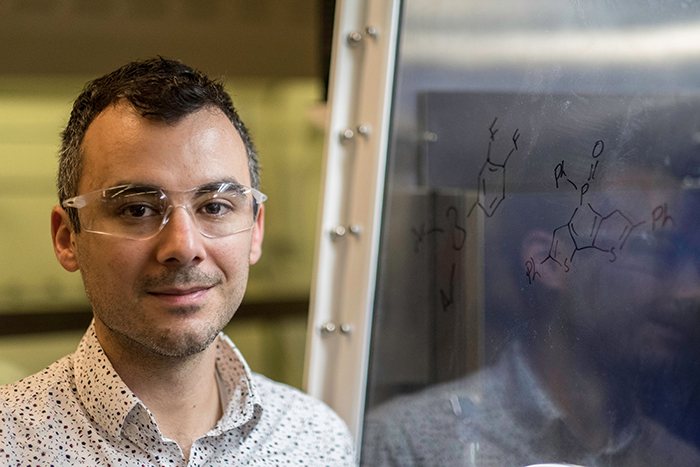
What is the science behind semi-permanent tattoo technology? Faculty of Science chemistry Professor Chris Caputo’s research is revolutionizing this form of personal expression in new and interesting ways for a Canadian startup.
By Krista Davidson
A York University research team is collaborating with Inkbox, a Toronto-based startup that uses semi-permanent tattoo technology, to better understand the science behind their revolutionary tattoo technology. The science could support the development of semi-permanent tattoos with different colours. Inkbox was acquired by Bic in January 2022 for U.S. $65 million.
Chris Caputo is an assistant professor in the Department of Chemistry and a Tier 2 Canada Research Chair in Metal-Free Materials for Catalysis. His research focuses on developing greener and more sustainable chemistry by eliminating the need to use expensive and toxic transition metals.
In 2015, Caputo met the Inkbox CEO and co-founder, Tyler Handley, and later became the company’s director of research and development before joining York University, where he continued to work with the company to develop their technology with the help of York’s Office of the Vice-President Research & Innovation (VPRI).
Inkbox’s revolutionary technology is different than a normal tattoo because it is a fruit-based extract that stains the epidermis layer of skin instead of being injected into the dermis layer, allowing the dyed skin to slough over time and enable the disappearance of the tattoo.

“We really wanted to understand the mechanism of how and why this fruit extract turns your skin dark blue when applied, so we could take that development a step further towards new colours,” says Caputo. “Our research at York has been fundamental to identifying the chemistry behind the process of developing new colours and helping Inkbox expand their R&D pipeline.”
Caputo was able to hire a team of researchers, one of which is now employed at Inkbox, and avail of the University’s state-of-the-art synthetic chemistry wet lab.
“A collaboration with Chris's group, funded by Mitacs and NSERC (Natural Sciences and Engineering Research Council of Canada) Collaborative Research & Development grants, has allowed Inkbox to do molecular-level research that would otherwise have been impossible with the budget of a startup company,” said Ian Mallov, manager, Formulation & Regulatory Affairs at Inkbox Tattoos.
“We were dealing with a blank canvas because nobody in the world has ever looked at this challenge before. It’s been a wonderful and exploratory project where we could take the time to refine our hypothesis and reach our goal towards achieving different colours,” said Caputo.
To date, Inkbox has filed several patents on the research undertaken through this collaboration. Caputo continues to collaborate with Inkbox and a small team of researchers, led by Sanjay Manhas, Charley Garrard and Nico Bonanno, who are currently working on projects at York. With the new Bic acquisition, Inkbox can expand its revolutionary technology to broader markets with new offerings.
“Chris has guided this research toward developing new tattoo ink dyes and understanding the mechanism of action of the current active dye. This has contributed significant value in terms of intellectual property for the company,” said Mallov.
Caputo's research, which includes developing efficient synthetic strategies, is supporting sustainability for Inkbox by finding ways to significantly reduce waste materials and energy needed to produce new dyes. This work supports the University’s goals in elevating York’s contributions to the United Nation’s 17 Sustainable Development Goals (SDGs), specifically SDG 12 which calls for sustainably managing natural resources, reducing and managing waste better, and promoting sustainable lifestyles and company practices.
The experience has been particularly eye-opening for Caputo and his team about the possibility of modifying molecules and manipulating dyes to support sustainability for other commercial products.
“We’ve potentially unlocked new properties for a natural product by taking a systematic synthetic chemistry approach. It has made me think about what other naturally occurring feedstocks we can apply this to for the generation of more sustainable dyes in the future,” said Caputo.
